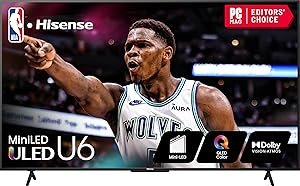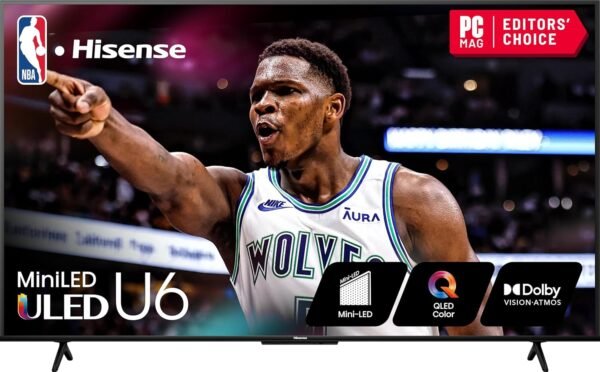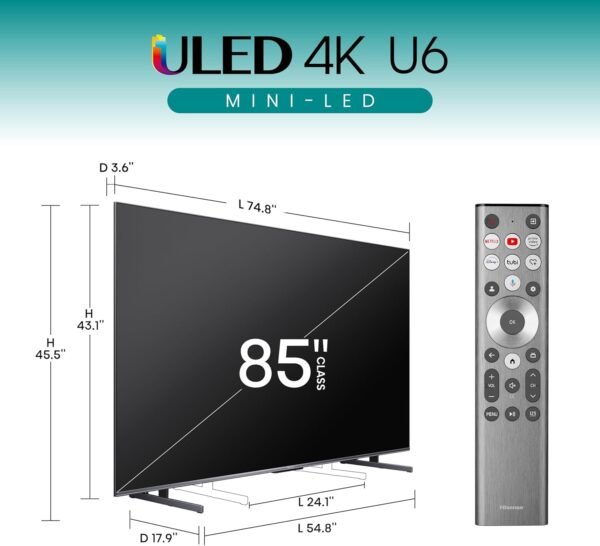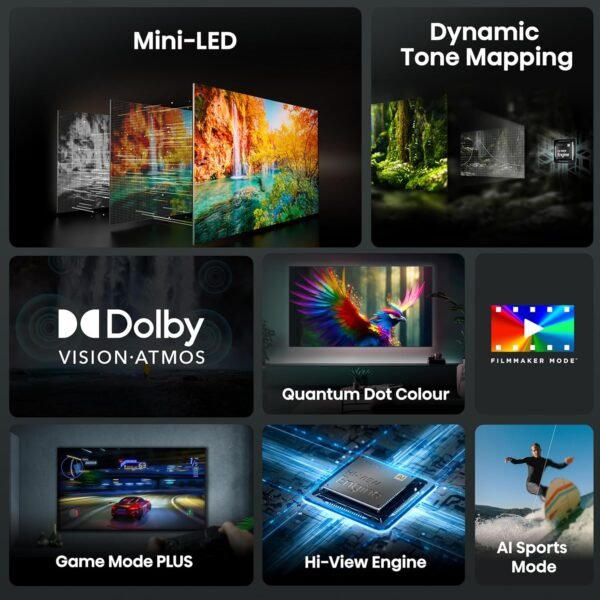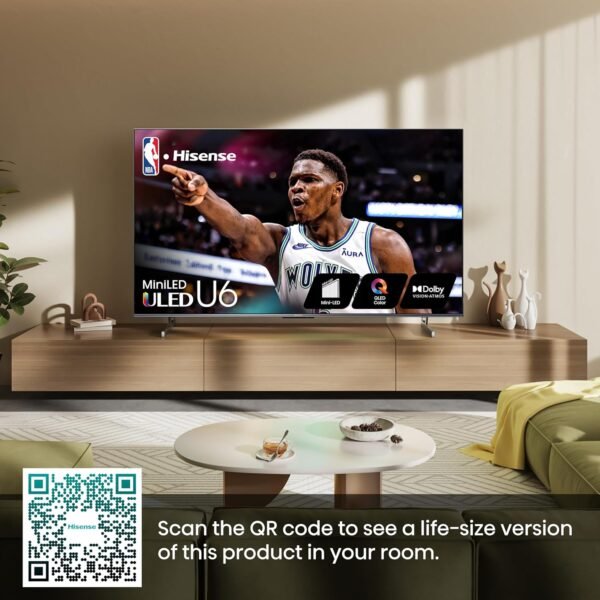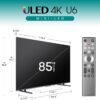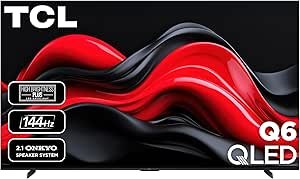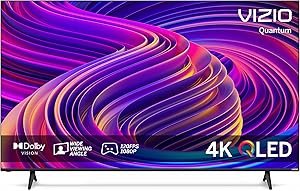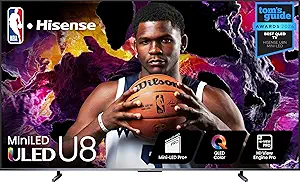Hisense 85-Inch U6 Series Mini-LED ULED TV review with QLED and HDR features
Hisense 85-Inch U6 Series Mini-LED ULED TV review with QLED and HDR features
- The vivid color reproduction is breathtaking, making every scene feel lifelike and immersive.
- The Dolby Vision and Atmos integration enhances both visuals and sound, creating a cinematic experience at home.
- Game Mode Plus ensures smooth performance, with no noticeable lag during fast-paced gaming sessions.
- The Mini-LED technology paired with Full Array Local Dimming brings out incredible contrasts, delivering deep blacks and bright highlights.
- Motion Rate 240 keeps fast-moving content crystal clear, perfect for sports and action-packed scenes.
As an Amazon Associate I earn from qualifying purchases.
Description
A Stunner for Entertainment: My Hands-On Experience With the Hisense 85-Inch Class U6 Series Mini-LED ULED 4K UHD Google Smart TV (85U6N)
The moment I unboxed this mini-LED behemoth, I was struck by its sleek design. As someone who spends a healthy amount of time binge-watching, gaming, and dissecting movie cinematography, I wanted a TV that would not just meet my needs but exceed them. The Hisense U6 Series 85U6N promised a lot with features like mini-LED technology, Dolby Vision, and Game Mode Plus—and I couldn’t wait to see if it delivered. Spoiler alert: it kind of does, but it’s not without its quirks.
Design and Build: A Behemoth That Commands Attention
Setting this TV up was almost as monumental as its size. At 85 inches, it’s a dominating presence in my living room. The thin bezels are a nice touch, adding a premium feel, and the stand is sturdy enough to keep this giant stable. However, if you’re tight on space, you might want to rethink either your furniture or this TV. Wall-mounting? Totally feasible, but you’ll need some extra muscle or a very persuasive call to a friend.
What I appreciated the most about the build was how clean it looked even after I connected all my devices. With four HDMI ports (including eARC), I hooked up my soundbar, gaming console, and Blu-ray player without a hitch. Unlike some TVs that leave you fumbling with limited connectivity, this setup felt effortless.
A Picture That Pops: Mini-LED and Quantum Dot Technology
Let’s talk about mini-LED technology, which Hisense touts as one of its standout features. Watching a movie like Blade Runner 2049 on this screen was breathtaking. The full-array local dimming does a stellar job of displaying deep blacks while preserving the bright highlights. It’s like seeing the stars pop against a pitch-black night sky—truly mesmerizing.
What elevates the viewing experience further is the QLED Quantum Dot Color technology, capable of producing over a billion shades. Colors appeared vibrant yet natural, whether it was the blue waves of the ocean or the rich, warm hues of a sunset. For anyone obsessed with visual detail (me, guilty), this feature is a game-changer.
That said, I did notice some minor blooming in high-contrast scenes, where the bright areas slightly bleed into the dark ones. While it’s not a dealbreaker, it’s something worth pointing out for the purists out there.
Audio: A Mixed Bag With Dolby Atmos
The Dolby Atmos sound feature is decent, but let’s not kid ourselves—built-in speakers can only do so much. I felt immersed during quieter scenes where dialogue was key, but the bass and overall “oomph” felt lacking during intense action sequences. If you’re serious about sound, a separate sound system or soundbar is a must. I paired mine with a mid-range soundbar, and the difference was night and day.
Gaming Performance: A Surprise Win for Gamers
As someone who spends countless hours on RPGs and first-person shooters, the Game Mode Plus was a pleasant surprise. Features like Auto Low Latency Mode (ALLM) and Variable Refresh Rate (VRR) ensured that gameplay was smooth and responsive. I tested it out with Elden Ring, and the quick screen transitions were buttery smooth. The 120Hz refresh rate felt like a godsend, particularly during high-action sequences.
But here’s where it gets a bit tricky. While the Motion Rate 240 is advertised as ideal for fast-paced games, I felt it occasionally over-processed the frames, leading to a slightly artificial look. It’s a matter of personal preference, but for me, it felt like a double-edged sword.
Smart Features: The Google TV Experience
Navigating through the Google TV interface felt intuitive. It aggregated all my streaming services—Netflix, HBO Max, YouTube—into a single dashboard, making it easier to browse without endlessly switching apps. What impressed me was the personalized recommendations based on my viewing habits. It felt like the TV was learning my tastes, which was both cool and mildly creepy.
The WiFi 6 support is another standout feature. Streaming in 4K HDR was seamless, with no buffering issues even when other devices in my home were using the network. For anyone fed up with laggy Netflix marathons, this is a lifesaver.
Key Benefits
- Stunning picture quality with mini-LED and Quantum Dot technology.
- Immersive gaming experience thanks to Game Mode Plus and VRR.
- Convenient connectivity with four HDMI ports, including eARC.
- Fast and smooth streaming aided by WiFi 6 support.
- User-friendly Google TV interface with personalized recommendations.
Adverse Aspects
- Minor blooming in high-contrast scenes, noticeable to the trained eye.
- Built-in sound lacks depth, requiring a soundbar for a fuller experience.
- The sheer size may not suit smaller living spaces.
- Occasional over-processing with Motion Rate 240, leading to an artificial feel.
Competing Brands: How Does It Stack Up?
Comparing this TV to its closest competitors, I was curious to see how it fared against Samsung’s QLED lineup and LG’s OLED series. Samsung’s QLED TVs also boast Quantum Dot technology, but the biggest advantage here was the Hisense’s mini-LED backlighting, which provided better contrast in most cases. On the other hand, LG’s OLED TVs still reign supreme in delivering perfect blacks and infinite contrast, though they come with a higher price tag.
For gamers, the Hisense holds its own quite well. The Game Mode Plus and VRR make it an excellent choice for anyone who prioritizes low latency and smooth gameplay. While LG’s OLEDs offer a similar gaming experience, they’ve been reported to face potential burn-in issues over time, something the Hisense avoids.
Bang for the Buck
Let’s address the elephant in the room: is it worth it? Considering the features packed into this TV, I’d say the price-to-quality ratio is solid. While it’s not the cheapest option out there, the combination of mini-LED, QLED, Dolby Vision, and advanced gaming features makes it a worthy investment for anyone who values premium visuals and versatile functionality. It’s not perfect, but it certainly delivers more than what you’d expect for its price bracket.
All in all, this TV has earned its place in my home, quirks and all. It’s a fantastic option for anyone looking to upgrade their entertainment setup, provided you’re aware of its few limitations. Whether you’re a movie buff, a gamer, or just someone who loves a big, beautiful screen, it’s hard not to be impressed by what this Hisense 85-inch U6 Series can do.
